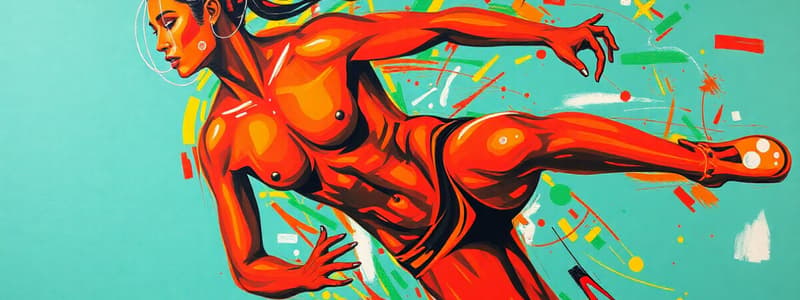Podcast
Questions and Answers
What is the main focus of Physical Cultural Studies (PCS)?
What is the main focus of Physical Cultural Studies (PCS)?
- To emphasize the historical context of physical education.
- To promote traditional kinesiology techniques.
- To reject interdisciplinary approaches.
- To analyze physical culture within social power dynamics. (correct)
Which publication focuses on the significance of the body in various domains?
Which publication focuses on the significance of the body in various domains?
- Body and Society (correct)
- The Body in Context
- Cultural Studies Review
- Journal of Kinesiology
Who contributed to the theoretical frameworks utilized in Body and Society?
Who contributed to the theoretical frameworks utilized in Body and Society?
- Michel Foucault, Judith Butler, and Barbara Kruger
- Simone de Beauvoir, Noam Chomsky, and Richard Dawkins
- Carl Jung, Sigmund Freud, and Erving Goffman
- Jean-Marie Brohm, Pierre Bourdieu, and Maurice Merleau-Ponty (correct)
What concept did Marcel Mauss introduce regarding the use of the body?
What concept did Marcel Mauss introduce regarding the use of the body?
What does the term 'somatic turn' in kinesiology advocate for?
What does the term 'somatic turn' in kinesiology advocate for?
Which regions were primarily focused on in the history of physical culture?
Which regions were primarily focused on in the history of physical culture?
What role did dancers and physical educators play in the evolution of body cultures?
What role did dancers and physical educators play in the evolution of body cultures?
What is a key goal of interdisciplinary approaches in kinesiology according to PCS?
What is a key goal of interdisciplinary approaches in kinesiology according to PCS?
What is the primary distinction between biological sex and gender?
What is the primary distinction between biological sex and gender?
How do Islamic fundamentalists and Western perspectives differ regarding women's attire in sports?
How do Islamic fundamentalists and Western perspectives differ regarding women's attire in sports?
What is a significant barrier for Muslim women participating in sports?
What is a significant barrier for Muslim women participating in sports?
What perspective does Islamic feminism take regarding the hijab?
What perspective does Islamic feminism take regarding the hijab?
What global influence is often in tension with local Islamic traditions regarding sports?
What global influence is often in tension with local Islamic traditions regarding sports?
Which statement best describes the representation of female Muslim athletes in media?
Which statement best describes the representation of female Muslim athletes in media?
What role does sport traditionally play within the context of 2SLGBTQI athletes?
What role does sport traditionally play within the context of 2SLGBTQI athletes?
What influences shape Muslim women's experiences of their bodies?
What influences shape Muslim women's experiences of their bodies?
What does the 'culture of risk' in sport primarily refer to?
What does the 'culture of risk' in sport primarily refer to?
What psychological impact does the culture of risk tend to have on athletes?
What psychological impact does the culture of risk tend to have on athletes?
How can narratives of illness play a role in an athlete’s recovery?
How can narratives of illness play a role in an athlete’s recovery?
What are structural role constraints in the context of sports?
What are structural role constraints in the context of sports?
Which of the following is NOT a risk associated with playing football?
Which of the following is NOT a risk associated with playing football?
What is the implication of media coverage regarding injuries in sports?
What is the implication of media coverage regarding injuries in sports?
What does advocating for athlete-centered policies aim to address in sports?
What does advocating for athlete-centered policies aim to address in sports?
Which of the following is a common consequence of the culture of risk for athletes?
Which of the following is a common consequence of the culture of risk for athletes?
Which group is identified as the most disadvantaged in terms of physical activity across the lifespan?
Which group is identified as the most disadvantaged in terms of physical activity across the lifespan?
What factor is cited as most influential during working age in relation to physical activity?
What factor is cited as most influential during working age in relation to physical activity?
How does the interaction of gender and immigrant status affect women after having a baby?
How does the interaction of gender and immigrant status affect women after having a baby?
During which life stage are habitual factors considered most important for physical activity patterns?
During which life stage are habitual factors considered most important for physical activity patterns?
What is a key takeaway regarding physical activity and social inequities?
What is a key takeaway regarding physical activity and social inequities?
In the study of physical activity among immigrant groups, which statement is true?
In the study of physical activity among immigrant groups, which statement is true?
What is emphasized as a crucial period for addressing physical activity among disadvantaged groups?
What is emphasized as a crucial period for addressing physical activity among disadvantaged groups?
What approach is recommended for studying inequality in physical activity?
What approach is recommended for studying inequality in physical activity?
Which aspect is emphasized by the political economy of health?
Which aspect is emphasized by the political economy of health?
How does feminism approach health in relation to societal structures?
How does feminism approach health in relation to societal structures?
What does intersectionality theory focus on in the context of health?
What does intersectionality theory focus on in the context of health?
In postmodern approaches to health, what does the term 'governmentality' refer to?
In postmodern approaches to health, what does the term 'governmentality' refer to?
What is a key concept in the sociology of the body as it relates to sport?
What is a key concept in the sociology of the body as it relates to sport?
What does the term 'medicalization' imply in a sociological context?
What does the term 'medicalization' imply in a sociological context?
According to Erving Goffman's concept of stigma, what defines a stigmatized individual?
According to Erving Goffman's concept of stigma, what defines a stigmatized individual?
Which of the following statements best reflects the impact of consumer culture on health?
Which of the following statements best reflects the impact of consumer culture on health?
What issue does the medical-industrial complex primarily address?
What issue does the medical-industrial complex primarily address?
Which statement best describes the role of race in the context of health according to anti-racist and post-colonial approaches?
Which statement best describes the role of race in the context of health according to anti-racist and post-colonial approaches?
What is a key component of athlete-centered care in rehabilitation?
What is a key component of athlete-centered care in rehabilitation?
Which factor is important for enhancing emotional resilience in athletes during recovery?
Which factor is important for enhancing emotional resilience in athletes during recovery?
How can cultural norms affect an athlete's recovery experience?
How can cultural norms affect an athlete's recovery experience?
What is an essential aspect of creating personalized rehabilitation plans?
What is an essential aspect of creating personalized rehabilitation plans?
What role do narratives play in the rehabilitation process?
What role do narratives play in the rehabilitation process?
Why is it important to resist injury narratives in sports?
Why is it important to resist injury narratives in sports?
What is the impact of access to healthcare on an athlete's recovery?
What is the impact of access to healthcare on an athlete's recovery?
How should rehabilitation consider long-term health outcomes for athletes?
How should rehabilitation consider long-term health outcomes for athletes?
Flashcards
Physical Cultural Studies (PCS)
Physical Cultural Studies (PCS)
A field that combines sociology, cultural studies, and history of physical activity to analyze physical culture within social power structures.
Techniques of the body
Techniques of the body
Ways societies teach individuals to use their bodies, influenced by education and imitation, connected to social processes and culture.
Body and Society Journal
Body and Society Journal
A publication exploring the body's significance across various domains, encompassing consumerism, everyday life, art and technology.
Historicizing Physical Culture
Historicizing Physical Culture
Signup and view all the flashcards
Somatic turn
Somatic turn
Signup and view all the flashcards
Body cultures
Body cultures
Signup and view all the flashcards
Social power dynamics
Social power dynamics
Signup and view all the flashcards
Physical cultural injustice
Physical cultural injustice
Signup and view all the flashcards
Gender vs. Sex
Gender vs. Sex
Signup and view all the flashcards
Internal vs. External Identity
Internal vs. External Identity
Signup and view all the flashcards
Veiling in Islam
Veiling in Islam
Signup and view all the flashcards
Islamic vs. Secular Feminism
Islamic vs. Secular Feminism
Signup and view all the flashcards
Challenges for Muslim Athletes
Challenges for Muslim Athletes
Signup and view all the flashcards
Media Representation of Muslim Athletes
Media Representation of Muslim Athletes
Signup and view all the flashcards
2SLGBTQI Participation in Sport
2SLGBTQI Participation in Sport
Signup and view all the flashcards
Sport as a Gendered Space
Sport as a Gendered Space
Signup and view all the flashcards
Political Economy of Health
Political Economy of Health
Signup and view all the flashcards
Medical-industrial Complex
Medical-industrial Complex
Signup and view all the flashcards
Feminist Approaches to Health
Feminist Approaches to Health
Signup and view all the flashcards
Medicalization
Medicalization
Signup and view all the flashcards
Stigma
Stigma
Signup and view all the flashcards
Intersectionality
Intersectionality
Signup and view all the flashcards
Post-colonial Approaches to Health
Post-colonial Approaches to Health
Signup and view all the flashcards
Governmentality
Governmentality
Signup and view all the flashcards
Social Construction of Bodies
Social Construction of Bodies
Signup and view all the flashcards
Healthism
Healthism
Signup and view all the flashcards
Racial Gap
Racial Gap
Signup and view all the flashcards
Lifecourse Perspective
Lifecourse Perspective
Signup and view all the flashcards
Habitual Factors
Habitual Factors
Signup and view all the flashcards
Structural Factors
Structural Factors
Signup and view all the flashcards
Racialized Immigrant Women
Racialized Immigrant Women
Signup and view all the flashcards
Working Age (Crucial Period)
Working Age (Crucial Period)
Signup and view all the flashcards
Policy Implications
Policy Implications
Signup and view all the flashcards
Athlete Narrative
Athlete Narrative
Signup and view all the flashcards
Holistic Support
Holistic Support
Signup and view all the flashcards
Tailored Rehabilitation
Tailored Rehabilitation
Signup and view all the flashcards
Multi-Dimensional Identity
Multi-Dimensional Identity
Signup and view all the flashcards
Social Support in Recovery
Social Support in Recovery
Signup and view all the flashcards
Contextual Factors in Recovery
Contextual Factors in Recovery
Signup and view all the flashcards
Personalized Rehab Plans
Personalized Rehab Plans
Signup and view all the flashcards
The 'Culture of Risk' in Sports
The 'Culture of Risk' in Sports
Signup and view all the flashcards
Culture of Risk in Sport
Culture of Risk in Sport
Signup and view all the flashcards
Socialization in Sport
Socialization in Sport
Signup and view all the flashcards
Athlete-Centred Policies
Athlete-Centred Policies
Signup and view all the flashcards
Returning to 'Illness Narratives'
Returning to 'Illness Narratives'
Signup and view all the flashcards
Normalization of Injury
Normalization of Injury
Signup and view all the flashcards
Diminished Self
Diminished Self
Signup and view all the flashcards
Role Constraints in Sport
Role Constraints in Sport
Signup and view all the flashcards
Media's Role in Sport Culture
Media's Role in Sport Culture
Signup and view all the flashcards
Study Notes
Week 1
- Sociology is the study of the relationship between individuals and society
- Health problems are often viewed as individual issues, but are also social
- Sociological imagination is a concept that links personal troubles to broader social issues
- The sociological imagination comprises four parts: historical, cultural, structural, and critical factors
- Structure and agency are examined in sociology, focusing on how individuals create society, while simultaneously being shaped by it.
Week 2
- The biomedical model of health emphasizes individual etiology, objectification, and reductionism.
- The social model of health emphasizes social construction of health and illness, social organization of healthcare, and societal production and distribution.
- Physical cultural studies explore how power structures shape embodied experiences.
- Kinesiology focuses on the biomedical approach, overshadowing social and cultural perspectives; often emphasizing the body as genetic, physiological, biological entity only.
Week 3
- Social constructions of aging examine how societal perceptions of aging, including prejudice (ageism), influence attitudes and roles.
- Physical activity is influenced by historical and cultural context
- Understanding ageism in both individual and societal contexts is important to understand how it impacts older people's participation in physical activity.
- The concepts of "sick role", "materialist", "conflict", "functionalist", and "feminist approaches" to the sociology of health are considered.
Week 4
- Bodies are understood in their social contexts, with a focus on gender, race, sexual orientation, and social identities constructed in different environments (for example, culturally or politically).
- Social constructions of gender explore how norms and expectations affect individuals' experiences in various contexts, especially sport.
- Intersectionality is an important factor to consider
- Muslim women's sports participation and experience are considered.
Week 5
- Disability is a social construction, not an individual issue
- Ability is not necessarily the opposite of disability
- Environmental issues influence our experience of disability
- The Social Model of Disability, with two approaches: Environmental and Rights-Outcome, are considered.
Week 6
- Medicalization of bodies - how societal pressures and norms shape our perceptions of bodies; and the role of doctors in controlling/regulating people.
- The 'scientific approach' to medicine in a biopsychosocial perspective is considered.
- The social and cultural factors influencing mental health are considered.
Week 7
- Exercise is Medicine (EiM): A global initiative that views exercise as a form of medicine for disease prevention and treatment; emphasizing its sociocultural implications and critiques of the concept.
- The concept examines the meanings and implications of exercise for individuals, and how these perspectives may differ. Key themes of critique of EiM are raised.
Week 8
- There is no week 8
Week 9
- Mental health in athletes and how it relates to social factors
- Understanding the link between mental health and social determinants of health (SDoH);
- An ecological systems approach to mental health promotion
Week 10
- Socially constructed death and dying processes
- The concept of 'social death' – isolation due to marginalization
- Modern medicine's impact on death and dying experiences
- Cultural and religious contexts in the understanding death.
Week 11
- Person-centered care and the importance of patient-centred care to ensure better health outcomes
- Key Principles of Person-Centred Care.
- Importance of a strong collaborative relationship between care givers and the patients
- The role of narrative, including the "culture of risk" in sport and illness narrative.
- The use of supportive environments in rehabilitation.
Week 12
- No week 12
Studying That Suits You
Use AI to generate personalized quizzes and flashcards to suit your learning preferences.




